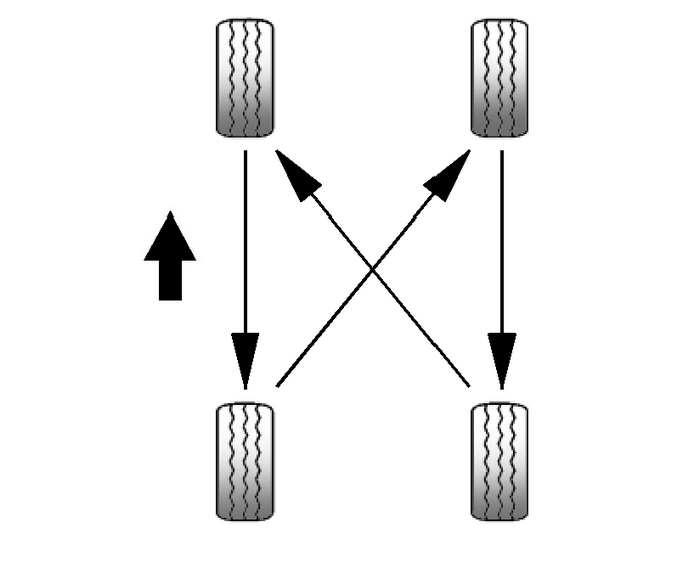Chevrolet Equinox Service Manual: Tire Rotation Wheels
Tires should be rotated every 12-000 km (7,500-mi). SeeMaintenance Schedule.
Tires are rotated to achieve a uniform wear for all tires. The first rotation is themost important.
Anytime unusual wear is noticed, rotate the tires as soon as possible, check for propertire inflation pressure, and check for damaged tires or wheels. If the unusual wearcontinues after the rotation, check the wheel alignment. SeeWhen It Is Time for New TiresandWheel Replacement.

Use this rotation pattern when rotating the tires.
Do not include the compact spare tire in the tire rotation.
Adjust the front and rear tires to the recommended inflation pressure on the Tireand Loading Information label after the tires have been rotated. SeeTire PressureandVehicle Load Limits.
Reset the Tire Pressure Monitor System. SeeTire Pressure Monitor Operation.
Check that all wheel nuts are properly tightened. See “Wheel Nut Torque” underCapacities and Specifications.
Warning:Rust or dirt on a wheel, or on the parts to which it isfastened, can make wheel nuts become loose after time. The wheelcould come off and cause an accident. When changing a wheel, removeany rust or dirt from places where the wheel attaches to thevehicle. In an emergency, a cloth or a paper towel can be used;however, use a scraper or wire brush later to remove all rust ordirt.
Lightly coat the center of the wheel hub with wheel bearing grease after a wheel changeor tire rotation to prevent corrosion or rust build-up. Do not get grease on the flatwheel mounting surface or on the wheel nuts or bolts.
 Tire Pressure Monitor Description and Operation TPMS
Tire Pressure Monitor Description and Operation TPMS
Tire Pressure Monitoring Block DiagramA5Driver Information CenterP16Instrument ClusterK9Body Control ModuleK77Remote Control Door Lock ReceiverT10Keyless Entry AntennaB2LFTire Pressure Sensor - Left F ...
 Toe Description Wheels
Toe Description Wheels
Toe is a measurement of how much the front and/or rear wheelsare turned in or out from a straight-ahead position. When thewheels are turned in, toe is positive-(+). When thewheels are turned out, toe ...
Other materials:
Radiator Drain Cock Replacement Engine Cooling Radiator
Radiator Drain Cock ReplacementCalloutComponent NamePreliminary ProceduresRaise and support the vehicle. Refer toLifting and Jacking the VehiclePlace a drain pan under the right side lower radiatormount.1Radiator Drain Cock ...
